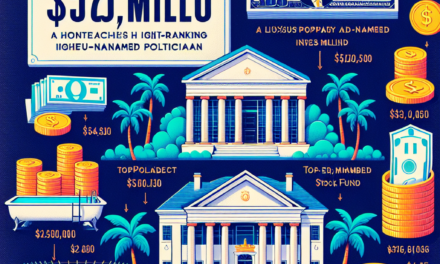“Villeroy Advocates for ECB’s Continued Easing: Aiming for Neutral Stance by Summer.”
Introduction
Villeroy, a prominent figure in the European Central Bank (ECB), has emphasized the importance of continued monetary easing to achieve a neutral stance by the summer. This approach reflects the ECB’s commitment to supporting economic recovery and stability in the Eurozone amid ongoing challenges. By maintaining accommodative policies, Villeroy advocates for a balanced approach that aims to foster growth while addressing inflationary pressures, ultimately guiding the economy towards a more sustainable trajectory. The focus on achieving a neutral stance underscores the ECB’s strategic vision for a resilient financial environment in the coming months.
Villeroy’s Perspective on ECB’s Easing Measures
In recent discussions surrounding the European Central Bank’s (ECB) monetary policy, François Villeroy de Galhau, the Governor of the Bank of France, has emerged as a prominent advocate for continued easing measures. His perspective is rooted in the belief that such actions are essential for steering the Eurozone economy towards a neutral stance by the summer. Villeroy’s insights reflect a broader understanding of the economic landscape, characterized by persistent challenges that necessitate a careful and measured approach to monetary policy.
Villeroy emphasizes that the current economic environment remains fragile, with inflationary pressures still evident in various sectors. While there have been signs of recovery, the pace has not been uniform across the Eurozone. This unevenness underscores the importance of maintaining accommodative monetary policies to support growth and stability. By advocating for continued easing, Villeroy aims to ensure that the recovery is not only sustained but also inclusive, benefiting all member states rather than a select few.
Moreover, Villeroy’s call for easing measures is informed by the need to address the lingering effects of the pandemic. The economic fallout from COVID-19 has left many businesses and households in precarious situations, and the path to recovery is fraught with uncertainties. In this context, Villeroy argues that the ECB must remain vigilant and responsive to the evolving economic landscape. He posits that a proactive approach, characterized by lower interest rates and supportive liquidity measures, will provide the necessary impetus for economic activity to regain momentum.
Transitioning from the immediate challenges, Villeroy also highlights the importance of achieving a neutral monetary policy stance. He believes that this goal is not merely a theoretical target but a practical necessity for fostering long-term economic stability. A neutral stance, in Villeroy’s view, would allow the ECB to balance the dual mandate of supporting growth while keeping inflation in check. This balance is crucial, as it would enable the central bank to respond effectively to future economic shocks without being constrained by overly tight monetary conditions.
Furthermore, Villeroy’s perspective is informed by the lessons learned from past monetary policy decisions. He cautions against the risks of premature tightening, which could stifle the nascent recovery and lead to adverse economic consequences. By advocating for a gradual and measured approach to easing, Villeroy seeks to create an environment conducive to sustainable growth. This approach not only supports businesses and consumers but also reinforces confidence in the Eurozone’s economic prospects.
In conclusion, Villeroy’s advocacy for continued easing by the ECB is a reflection of his commitment to fostering a resilient and inclusive economic recovery. His emphasis on achieving a neutral stance by summer underscores the importance of a balanced approach to monetary policy, one that is responsive to current challenges while remaining forward-looking. As the Eurozone navigates the complexities of its economic landscape, Villeroy’s insights serve as a guiding framework for policymakers, emphasizing the need for vigilance, adaptability, and a steadfast commitment to supporting growth in the face of uncertainty. Ultimately, the path forward will require a concerted effort to ensure that the benefits of recovery are widely shared, paving the way for a more robust and sustainable economic future.
The Impact of ECB’s Policies on Eurozone Inflation
The European Central Bank (ECB) plays a pivotal role in shaping the economic landscape of the Eurozone, particularly through its monetary policy decisions. As inflation continues to be a pressing concern across the region, the implications of the ECB’s policies are increasingly scrutinized. In recent discussions, ECB Governing Council member François Villeroy de Galhau has advocated for a continued easing of monetary policy, emphasizing the necessity of achieving a neutral stance by the summer. This perspective highlights the delicate balance the ECB must maintain in addressing inflation while fostering economic growth.
To understand the impact of the ECB’s policies on Eurozone inflation, it is essential to consider the current economic environment. Inflation rates have surged in many Eurozone countries, driven by a combination of factors including supply chain disruptions, rising energy prices, and increased consumer demand as economies recover from the pandemic. In response, the ECB has implemented a series of measures aimed at stabilizing prices and supporting economic recovery. These measures include lowering interest rates and engaging in asset purchase programs, which are designed to inject liquidity into the economy and encourage lending.
However, the effectiveness of these policies in curbing inflation remains a topic of debate. While some economists argue that the ECB’s accommodative stance has been instrumental in preventing a deeper economic downturn, others caution that prolonged easing could lead to overheating in the economy. Villeroy’s call for continued easing reflects a belief that the current inflationary pressures may be transitory and that a cautious approach is necessary to avoid stifling growth. By advocating for a neutral stance by summer, he suggests that the ECB should remain vigilant and responsive to evolving economic conditions.
Moreover, the relationship between monetary policy and inflation is complex and multifaceted. The ECB must consider not only the immediate effects of its policies but also their long-term implications. For instance, while low interest rates can stimulate borrowing and spending, they may also contribute to asset bubbles and increased consumer debt. As such, the ECB faces the challenge of navigating these potential pitfalls while striving to maintain price stability. Villeroy’s emphasis on achieving a neutral stance indicates a recognition of this complexity, as it seeks to balance the need for continued support with the imperative of sustainable economic growth.
In addition to these considerations, the ECB’s policies also have significant implications for the broader Eurozone economy. A stable inflation rate is crucial for maintaining consumer confidence and encouraging investment. If inflation expectations become unanchored, it could lead to a vicious cycle of rising prices and wage demands, further complicating the ECB’s efforts to manage the economy. Therefore, Villeroy’s advocacy for continued easing is not merely a response to current inflationary pressures but also a strategic move to ensure that the Eurozone remains on a path toward stability and growth.
In conclusion, the impact of the ECB’s policies on Eurozone inflation is a critical issue that requires careful consideration. As Villeroy calls for continued easing to achieve a neutral stance by summer, it is essential to recognize the intricate dynamics at play. The ECB must navigate the challenges of inflation while fostering an environment conducive to economic recovery. Ultimately, the success of these policies will depend on the ECB’s ability to adapt to changing economic conditions and maintain a delicate balance between supporting growth and ensuring price stability.
Analyzing the Timeline for Achieving Neutral Stance
In recent discussions surrounding monetary policy, the European Central Bank (ECB) has faced increasing scrutiny regarding its approach to interest rates and inflation control. Villeroy, a prominent figure within the ECB, has been vocal in advocating for a continued easing of monetary policy. His perspective is rooted in the belief that achieving a neutral stance by the summer is not only feasible but essential for the stability of the Eurozone economy. To understand the implications of this stance, it is crucial to analyze the timeline and the factors that will influence the ECB’s decisions in the coming months.
Firstly, the concept of a neutral stance refers to a monetary policy position that neither stimulates nor restricts economic growth. It is a delicate balance that the ECB aims to achieve, particularly in the context of fluctuating inflation rates and varying economic performance across member states. Villeroy’s call for continued easing suggests that he perceives current interest rates as potentially restrictive, which could hinder economic recovery and growth. By advocating for a more accommodative policy, he emphasizes the need for the ECB to support businesses and consumers alike, thereby fostering a more robust economic environment.
Moreover, the timeline for achieving this neutral stance is critical. Villeroy has indicated that the summer months present a pivotal opportunity for the ECB to reassess its policies. This timeframe aligns with various economic indicators that are expected to provide clearer insights into inflation trends and growth trajectories. As the Eurozone emerges from the challenges posed by the pandemic, it is essential for the ECB to remain agile and responsive to changing economic conditions. The summer months, therefore, serve as a natural checkpoint for evaluating the effectiveness of current policies and making necessary adjustments.
In addition to timing, external factors will play a significant role in shaping the ECB’s approach. Global economic conditions, including supply chain disruptions and geopolitical tensions, can have profound effects on inflation and growth within the Eurozone. Villeroy’s advocacy for continued easing reflects an understanding of these complexities. He recognizes that the ECB must navigate a landscape marked by uncertainty, and a cautious approach to tightening monetary policy could mitigate potential risks. By maintaining a supportive stance, the ECB can better position itself to respond to unforeseen challenges that may arise.
Furthermore, the communication strategy employed by the ECB will be crucial in managing market expectations. Villeroy’s public statements serve not only to influence policy but also to reassure investors and consumers about the central bank’s commitment to fostering economic stability. Clear and consistent messaging will help to build confidence in the ECB’s actions, thereby reinforcing the effectiveness of its policies. As the summer approaches, the ECB will need to articulate its rationale for any adjustments to interest rates, ensuring that stakeholders understand the underlying economic conditions driving these decisions.
In conclusion, Villeroy’s advocacy for continued easing by the ECB underscores the importance of achieving a neutral stance by summer. The interplay of economic indicators, external factors, and effective communication will be pivotal in guiding the ECB’s decisions. As the Eurozone navigates the complexities of recovery, the central bank’s ability to adapt its policies in response to evolving conditions will be essential for fostering sustainable growth and stability. Ultimately, the coming months will be critical in determining the trajectory of monetary policy and its impact on the broader economy.
Villeroy’s Vision for Economic Stability in Europe
In the context of the ongoing economic challenges facing Europe, the insights of François Villeroy de Galhau, the Governor of the Banque de France, have garnered significant attention. Villeroy has been a vocal advocate for the European Central Bank (ECB) to continue its easing measures, emphasizing the necessity of achieving a neutral monetary stance by the summer. His perspective is rooted in a comprehensive understanding of the current economic landscape, which is characterized by sluggish growth, persistent inflationary pressures, and the lingering effects of the COVID-19 pandemic.
Villeroy’s vision for economic stability in Europe hinges on the belief that a gradual and sustained approach to monetary policy is essential. He argues that the ECB must remain vigilant in its efforts to support the economy, particularly in light of the uncertainties that continue to cloud the European financial environment. By advocating for continued easing, Villeroy underscores the importance of maintaining liquidity in the markets, which is crucial for fostering investment and consumer confidence. This approach, he contends, will not only help stabilize the economy but also pave the way for a more robust recovery.
Moreover, Villeroy’s call for a neutral stance by summer reflects a strategic outlook that balances the need for immediate support with the recognition that the economic landscape is evolving. He acknowledges that while current easing measures are necessary, there is a finite window in which these policies can be effective. As the economy begins to show signs of recovery, it is imperative that the ECB transitions towards a more neutral position, thereby avoiding the pitfalls of prolonged accommodative policies that could lead to asset bubbles or excessive inflation.
In addition to advocating for continued easing, Villeroy emphasizes the importance of clear communication from the ECB. He believes that transparency regarding monetary policy decisions is vital for managing market expectations and ensuring that businesses and consumers can make informed decisions. By articulating a clear path towards normalization, the ECB can instill confidence in its commitment to economic stability, which is essential for fostering a conducive environment for growth.
Furthermore, Villeroy’s perspective is informed by the broader context of global economic trends. As central banks around the world grapple with similar challenges, the ECB’s approach must be calibrated not only to domestic conditions but also to international developments. The interconnectedness of global markets means that decisions made by the ECB will have far-reaching implications, necessitating a careful consideration of external factors that could influence the European economy.
In conclusion, François Villeroy de Galhau’s advocacy for continued easing by the ECB is a reflection of his commitment to fostering economic stability in Europe. By emphasizing the need for a gradual transition to a neutral stance by summer, he highlights the delicate balance that must be struck between providing immediate support and preparing for future challenges. His call for clear communication further underscores the importance of transparency in monetary policy, which is essential for building confidence among market participants. As Europe navigates the complexities of its economic recovery, Villeroy’s insights will undoubtedly play a crucial role in shaping the discourse around monetary policy and its implications for the continent’s future.
The Role of Interest Rates in ECB’s Easing Strategy
In the context of the European Central Bank’s (ECB) monetary policy, interest rates play a pivotal role in shaping economic conditions across the Eurozone. As the ECB navigates the complexities of a post-pandemic recovery, the need for a strategic approach to interest rates becomes increasingly apparent. Villeroy, a prominent figure within the ECB, has been vocal in advocating for continued easing measures, emphasizing the importance of achieving a neutral monetary stance by the summer. This perspective underscores the delicate balance the ECB must maintain in fostering economic growth while managing inflationary pressures.
Interest rates serve as a primary tool for the ECB to influence economic activity. By adjusting the rates at which banks can borrow from the central bank, the ECB can either stimulate or cool down the economy. Lowering interest rates typically encourages borrowing and spending, which can invigorate economic growth. Conversely, raising rates can help to temper inflation by making borrowing more expensive, thereby reducing consumer spending and investment. In the current economic climate, where recovery is still fragile and inflationary pressures are beginning to emerge, the ECB faces the challenge of determining the appropriate level of interest rates to support sustainable growth.
Villeroy’s call for continued easing reflects a recognition of the ongoing uncertainties that characterize the Eurozone’s economic landscape. The lingering effects of the pandemic, coupled with geopolitical tensions and supply chain disruptions, have created an environment where businesses and consumers remain cautious. In this context, maintaining lower interest rates can provide the necessary support to encourage investment and consumption, ultimately driving economic recovery. By advocating for a gradual approach to easing, Villeroy highlights the importance of not prematurely tightening monetary policy, which could stifle growth and hinder the recovery process.
Moreover, achieving a neutral stance by summer is a critical objective for the ECB. A neutral monetary policy is one that neither stimulates nor restricts economic activity, allowing the economy to operate at its full potential. Villeroy’s emphasis on this goal suggests a desire for the ECB to transition smoothly from its current accommodative stance to one that is more balanced. This transition is essential not only for fostering economic stability but also for ensuring that inflation remains within target levels. As the ECB considers its next steps, the role of interest rates will be central to this strategic shift.
In addition to supporting economic growth, the ECB’s approach to interest rates must also take into account the expectations of market participants. Clear communication regarding the central bank’s intentions can help to manage these expectations, reducing uncertainty and volatility in financial markets. Villeroy’s advocacy for continued easing is, therefore, not only about the immediate economic benefits but also about establishing a framework that allows for a predictable and stable monetary environment. This predictability is crucial for businesses and consumers alike, as it enables them to make informed decisions regarding investment and spending.
In conclusion, the role of interest rates in the ECB’s easing strategy is multifaceted and critical to achieving a neutral monetary stance by summer. Villeroy’s insights reflect a broader understanding of the economic challenges facing the Eurozone and the need for a careful, measured approach to monetary policy. By continuing to advocate for easing measures, the ECB can support economic recovery while laying the groundwork for a balanced and sustainable future. As the central bank navigates this complex landscape, the careful calibration of interest rates will remain a cornerstone of its strategy.
Market Reactions to ECB’s Continued Easing
The European Central Bank (ECB) has been at the forefront of monetary policy discussions, particularly as it navigates the complexities of economic recovery in the Eurozone. Recently, ECB Governing Council member François Villeroy de Galhau has advocated for a continued easing of monetary policy, emphasizing the necessity of achieving a neutral stance by the summer. This call for sustained easing has elicited varied reactions from the financial markets, reflecting the intricate interplay between central bank policies and investor sentiment.
As Villeroy’s comments reverberated through the financial landscape, market participants began to reassess their expectations regarding interest rates and economic growth. The prospect of continued easing suggests that the ECB is committed to supporting the economy, particularly in light of persistent inflationary pressures and uneven recovery across member states. Consequently, bond markets reacted swiftly, with yields on government bonds declining as investors priced in the likelihood of prolonged low interest rates. This decline in yields indicates a growing consensus that the ECB will maintain its accommodative stance, thereby fostering an environment conducive to borrowing and investment.
Moreover, the equity markets responded positively to Villeroy’s remarks, with major indices experiencing upward momentum. Investors interpreted the call for continued easing as a signal that the ECB remains focused on stimulating economic activity, which in turn bolsters corporate earnings prospects. As a result, sectors sensitive to interest rates, such as real estate and utilities, saw significant gains, reflecting a broader appetite for risk among investors. This shift in sentiment underscores the importance of central bank communication in shaping market dynamics, as participants adjust their strategies in response to policy signals.
In addition to the bond and equity markets, the foreign exchange market also exhibited notable reactions. The euro experienced fluctuations against major currencies, as traders weighed the implications of Villeroy’s comments on the ECB’s future policy trajectory. A dovish stance from the ECB typically exerts downward pressure on the euro, as lower interest rates can diminish the currency’s appeal to investors seeking yield. Consequently, the euro’s performance against the dollar and other currencies became a focal point for traders, who closely monitored developments in the ECB’s policy framework.
Furthermore, the commodities market was not immune to the effects of the ECB’s continued easing. As the central bank signals its commitment to maintaining low interest rates, the potential for increased liquidity in the economy can lead to higher demand for commodities. This relationship is particularly evident in the case of precious metals, such as gold, which often serve as a hedge against inflation and currency depreciation. As investors anticipate a prolonged period of accommodative monetary policy, demand for gold has surged, driving prices higher and reflecting a broader trend of seeking safe-haven assets amid economic uncertainty.
In conclusion, Villeroy’s advocacy for continued easing by the ECB has sparked a multifaceted response across various financial markets. The interplay between central bank policy and market reactions highlights the critical role that monetary policy plays in shaping economic expectations. As the ECB aims to achieve a neutral stance by summer, market participants will continue to closely monitor developments, adjusting their strategies in response to the evolving economic landscape. Ultimately, the effectiveness of the ECB’s policies will be measured not only by their immediate impact on markets but also by their ability to foster sustainable economic growth in the Eurozone.
Future Implications of ECB’s Neutral Stance on Growth
The European Central Bank (ECB) has been navigating a complex economic landscape, and the call for a continued easing of monetary policy by policymakers like Villeroy underscores the importance of achieving a neutral stance by the summer. This neutral stance is not merely a theoretical concept; it has profound implications for economic growth across the Eurozone. As the ECB considers its next steps, understanding the potential outcomes of this approach becomes crucial for both policymakers and market participants.
To begin with, a neutral monetary policy stance is characterized by interest rates that neither stimulate nor restrain economic activity. This balance is essential for fostering an environment conducive to sustainable growth. If the ECB successfully transitions to this neutral position, it could signal to businesses and consumers that the central bank is committed to maintaining stability in the financial system. Such stability is vital for encouraging investment, as businesses are more likely to commit capital when they perceive a predictable economic environment. Consequently, this could lead to increased capital expenditures, which are essential for driving productivity and innovation.
Moreover, achieving a neutral stance may also have significant implications for inflation management. The ECB has been grappling with the challenge of ensuring that inflation remains within its target range. By adopting a neutral policy, the central bank can create a framework that allows for gradual adjustments in response to changing economic conditions. This flexibility is particularly important in a post-pandemic recovery phase, where supply chain disruptions and labor market shifts can lead to unexpected inflationary pressures. A well-calibrated neutral stance would enable the ECB to respond effectively to these challenges, thereby supporting price stability and fostering consumer confidence.
In addition to these economic dynamics, the implications of a neutral stance extend to the labor market. A stable economic environment, bolstered by a neutral monetary policy, can enhance job creation and reduce unemployment rates. When businesses feel confident in their growth prospects, they are more likely to expand their workforce. This, in turn, can lead to increased consumer spending, as more individuals gain employment and disposable income rises. The virtuous cycle of job creation and spending can significantly contribute to overall economic growth, reinforcing the importance of the ECB’s approach.
Furthermore, the global economic context cannot be overlooked. As central banks worldwide adjust their monetary policies in response to varying economic conditions, the ECB’s ability to maintain a neutral stance will influence the Eurozone’s competitiveness on the global stage. A well-timed transition to neutrality could enhance the attractiveness of Eurozone assets, drawing foreign investment and supporting the euro’s value. This influx of capital can further stimulate growth, creating a positive feedback loop that benefits the entire region.
In conclusion, the future implications of the ECB’s neutral stance on growth are multifaceted and significant. By fostering an environment of stability, encouraging investment, managing inflation, and supporting job creation, the ECB can play a pivotal role in shaping the Eurozone’s economic trajectory. As Villeroy and other policymakers advocate for continued easing, it is essential to recognize that the path to a neutral stance is not merely a technical adjustment; it is a strategic move that holds the potential to unlock sustainable growth and resilience in the face of evolving economic challenges. The careful navigation of this transition will be critical in determining the Eurozone’s economic health in the years to come.
Q&A
1. **Question:** What is Villeroy’s stance on the ECB’s monetary policy?
**Answer:** Villeroy advocates for continued easing by the ECB to achieve a neutral stance by summer.
2. **Question:** What does Villeroy mean by “neutral stance”?
**Answer:** A neutral stance refers to a monetary policy that neither stimulates nor restricts economic growth, aiming for stable inflation and growth.
3. **Question:** Why does Villeroy support continued easing?
**Answer:** Villeroy believes that continued easing is necessary to support economic recovery and ensure inflation targets are met.
4. **Question:** What timeframe does Villeroy suggest for achieving this neutral stance?
**Answer:** Villeroy suggests that the ECB could achieve a neutral stance by the summer.
5. **Question:** How does Villeroy’s view align with other ECB officials?
**Answer:** Villeroy’s view aligns with other officials who also support a cautious approach to monetary policy amid economic uncertainties.
6. **Question:** What are the potential risks of not continuing easing?
**Answer:** Not continuing easing could lead to slower economic growth and failure to reach inflation targets, risking deflationary pressures.
7. **Question:** What tools might the ECB use to implement this easing?
**Answer:** The ECB may use tools such as lowering interest rates, quantitative easing, and other liquidity measures to implement continued easing.
Conclusion
Villeroy’s advocacy for continued easing by the European Central Bank (ECB) underscores the necessity of maintaining accommodative monetary policy to support economic recovery. By aiming for a neutral stance by summer, the ECB seeks to balance inflation control with growth stimulation, ensuring that the economy can sustain momentum without overheating. This approach reflects a cautious optimism about the economic outlook while recognizing the challenges posed by external factors. Ultimately, Villeroy’s position highlights the importance of a measured and responsive monetary policy in navigating the post-pandemic economic landscape.





